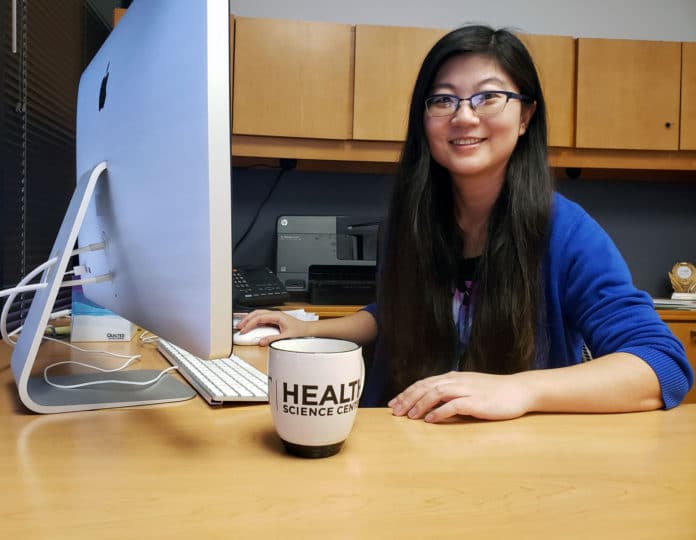Cut. Copy. Paste.
It’s now as easy as the click of a button: gene-editing, or altering DNA, the very essence that defines every organism.
The credit for which mainly goes to the technology CRISPR-Cas9. Introduced as a gene-editing device less than a decade ago, the CRISPR-Cas9 system has made hacking DNA much accessible and cheaper.
Genetically modified human beings might be the norm in the not-so-distant future. It is destined to happen, said Jin Liu, assistant professor of Pharmaceutical Sciences at UNT Health Science Center.
Through molecular dynamics, a computer simulation method, Liu has been cleaving sections of molecules and attaching new molecules and enzymes at its place. Like a tailor for genes, Liu has been working on a CRISPR-Cas9-related project for over 3 years in the UNT Health Science Center labs.
As human lives are at stake, her main concern is the safety aspect of the technology.
“This technology will be very helpful to serve those people who are in need, who have genetic diseases, we can help those people,” Liu said. “But, if you really want to change the history of human beings by designing, by creating CRISPR babies, then it’s a different thing.”
So, Liu and her team’s research tried to make the technology better and safer to use. And she has likely found a breakthrough.
The promising CRISPR technology has the potential to cure various forms of cancer and other diseases such as sickle cell anemia, AIDS, cystic fibrosis, Huntington’s disease and muscular dystrophy.
CRISPR-Cas9 technology uses a template RNA — the organic component that carries instructions for DNA — and the Cas9 enzyme that searches for matching compositions and then cuts the area once found. A new DNA template repairs the cut and alters the gene.
“And the problem is that, sometimes, even if it’s not a perfect match, it still cuts,” Liu said. “So that means it cuts at the wrong place. If this system is cutting our human DNA at the wrong place and modify it at wrong places, then it could cause trouble.”
This cutting of DNA at the wrong place is given the term “off-target effects.” And it carries the risk of undesired mutations or even the conception of new genetic diseases.
The UNTHSC team developed a new CRISPR-Cas9 tool that efficiently and accurately cuts DNA with no off-target effects. The engineered tool has improved specificity and may significantly enhance applications of CRISPR-Cas9 for therapeutic use requiring a high level of precision.
Liu has successfully tested her CRISPR-Cas9 tool in stem cells. She has now moved on to genome sequencing of entire cells.
“We are very happy,” Liu said, “because this will be a big advancement of this technology.”
The next step would be clinical trials. That would be followed by the real-life application of this technology and finally, it could help cure genetic diseases.
Liu’s team filed for an intellectual property patent on its CRISPR-Cas9 design late last year.
As the team waits on the pending patent, a number of pharmaceutical and medical research companies have already shown interest in the technology.
UNTHSC has received requests locally and internationally to know more about the technology, Liu said. She said the list ranges from local investors to a company in England.
“Some of those companies want to license this [technology], some people would like to use it for certain disease, some of them like to further develop this for specific reasons,” Liu said.
The easy gene-editing that CRISPR-Cas9 provides has implications and likely usage in industries not limited to health care. From agriculture and energy to animal conservation and national security, the global market has increasingly started to take notice of CRISPR-Cas9.
According to a report by BioInformatics, a leading pharmaceutical market analyst firm, the annual revenue for the CRISPR-Cas9 market will reach $3.61 billion by 2021.
However, the level of contribution Liu’s research might provide is yet to be known.
“Several companies have expressed interest in her work,” said Claude Longoria, director of UNTHSC’s Department of Research Development & Commercialization. “This is another example of the innovative research underway at the Health Science Center that could help change the way we treat and prevent disease.”
Because the project is in its early stages, the Office of Research Development and Commercialization at UNTHSC said it could not disclose any specifics or details of the ongoing processes with external companies.
“The research and technologies that Dr. Liu is pursuing show great potential to deepen understanding of the CRISPR-Cas9 gene-editing system and to advance the development of future therapeutic applications that could one day change people’s lives,” Longoria said.
Zhicheng Zuo, a post-doctoral research associate, worked with Liu in the CRISPR-Cas9 research. Together, the two have co-authored and published a few scientific papers.
Zuo presented their CRISPR-Cas9 specificity study findings at the annual Biophysical Society Meeting in Baltimore in March.
“The experience working with Dr. Liu is wonderful and impressive,” Zuo said. “In doing the CRISPR-Cas9 projects, gradually I have learned to raise new scientific questions, form own ideas, and rationally design experiments to test my hypotheses.”
But the partnership is coming to an end. Zuo has accepted a professor position at a Chinese university. He leaves for China later this April.
Zuo will continue to work on CRISPR in China, where he said things are a little different than the U.S. and restrictions are rather lax.
On November 2018, a Chinese scientist announced he had successfully altered embryos with CRISPR that led to the birth of the world’s first genetically edited babies, named Lulu and Nana, and made them who resistant to HIV.
The scientist, He Jiankui, and his claim have captivated the international scientific community about the technology’s future.
There are still lots of fundamental concerns scientists and people around the world will have to decide upon, Zuo said.
“As the CRISPR technology gets increasingly improved, I have no doubt about its medical applications in the future,” Zuo said. “With this revolutionary technology, the public health must be greatly enhanced in a way that we can never imagine before.”








